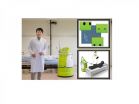Job-sharing with nursing robot
Conciliatory approach to human-robot symbiosis through development of 'Terapio' medical round support robot
2015-05-27
(Press-News.org) Given the aging of the population and the low birthrate both in Japan and elsewhere, healthcare professionals are in short supply and unevenly distributed, giving rise to a need for alternatives to humans for performing simple tasks. Although increasing numbers of medical institutions have introduced electronic medical records, a variety of issues remain unresolved, such as the inconvenience of data recording and the high costs associated with data input.
The use of robots to support medical care data management and the delivery of resources at the medical front--thus allowing humans to concentrate on those tasks requiring knowledge, skill, and experience--is expected to contribute to the enhancement of the quality of healthcare services.
Now, researchers at Toyohashi Tech have developed "Terapio," a next-generation robot that replaces the conventional medical cart used by healthcare staff during their rounds in a hospital.
Terapio assists staff in delivering resources and recording round information with its friendly communication abilities.
Terapio is an autonomous mobile robot that can track a person. It uses a differential-drive steering system to provide both quiet operation and smooth omnidirectional mobility. It recognizes its environment and autonomously tracks a specified human while avoiding obstacles. Using the Terapio's ring-shaped power-assist handle, an operator can control the robot accurately by applying a slight force. Terapio can also record patients' personal and vital signs data and also display data, such as the patient's health records. In terms of its exterior design and color scheme, Terapio is suitable for use in medical institutions. The touch panel on the top of Terapio is used for operating the robot and inputting/displaying round data. It is designed such that the operator and patient can recognize the robot's status and actions by expressions shown on the display that change according to the robot's operation mode, which are "power assist," "tracking," and "rounds."
The LCD display on the top of Terapio serves as the robot's "face." It changes its expression by changing the shape of its "eyes." Unlike the metallic, cold impression of a cart, these eyes give Terapio a human-like, friendly, and communicative persona.
"As we were developing Terapio, we could clearly imagine the human-robot symbiosis. By constantly promoting the pursuit of system integration technology, life with robots will be a reality in the near future," said assistant professor Ryosuke Tasaki. "An ongoing daily effort to incorporate high-tech robotics into our activities will be the best way to realize life in our future society."
When medical and nursing care workers are released from menial and back-breaking work by sharing their duties with a robot, they will be able to concentrate more on interacting with their patients and providing knowledgeable, kind, and compassionate care. Terapio can also elicit warmth from the humans with which it interacts. The researchers expect that similar research will become widespread in the future as more people adopt a conciliatory approach to human-robot symbiosis.
INFORMATION:
Reference:
Ryosuke Tasaki, Michiteru Kitazaki, Jun Miura, Kazuhiko Terashima (2015): Prototype Design of Medical Round Supporting Robot "Terapio", In the proceedings of the IEEE International Conference on Robotics and Automation (ICRA-2015), Paper WeA2T4.3. Presented May 27th 2015 at the Washington State Convention Center in Seattle, Washington, USA.
Further information:
Toyohashi University of Technology
1-1 Hibarigaoka, Tempaku
Toyohashi, Aichi Prefecture, 441-8580, JAPAN
Inquiries: Committee for Public Relations
E-mail: press@office.tut.ac.jp
Toyohashi University of Technology, founded in 1976 as a National University of Japan, is a research institute in the fields of mechanical engineering, advanced electronics, information sciences, life sciences, and architecture.
Website: http://www.tut.ac.jp/english/
ELSE PRESS RELEASES FROM THIS DATE:
2015-05-27
A breakthrough in machine learning has also brought about a "game changer" for the science of metabolomics - and will hasten the development of diagnostic and predictive tests for Alzheimer's, cancer, diabetes and numerous other conditions, leading to improved prevention and treatment.
University of Alberta computing science PhD graduate Siamak Ravanbakhsh published his research in the scientific journal PLOS ONE on an automated process that increases the speed and accuracy of producing a person's metabolic profile from a sample of biofluid such as blood serum or cerebrospinal ...
2015-05-27
A major international randomized clinical trial has found that HIV-infected individuals have a considerably lower risk of developing AIDS or other serious illnesses if they start taking antiretroviral drugs sooner, when their CD4+ T-cell count--a key measure of immune system health--is higher, instead of waiting until the CD4+ cell count drops to lower levels. Together with data from previous studies showing that antiretroviral treatment reduced the risk of HIV transmission to uninfected sexual partners, these findings support offering treatment to everyone with HIV.
The ...
2015-05-27
(Boston)--Reductions in federal support and clinical revenue not only jeopardize biomedical research at academic medical centers, but may ultimately impact clinical medicine according to an opinion piece in the journal Science Translational Medicine.
Biomedical research is crucial to the US national agenda and academic medical centers--the provenance for much of this research - are at particular risk, according to the authors. Persistent constraints on federal funding threaten to undermine this, and decreasing clinical revenue due to increasingly constrained reimbursement ...
2015-05-27
(SACRAMENTO, Calif.) -- Do microbes grow differently on the International Space Station than they do on Earth? Results from the growth of microbes collected by citizen scientists in Project MERCCURI indicate that most behave similarly in both places.
"While this data is extremely preliminary, it is potentially encouraging for long-term manned spaceflight," said David Coil, Ppoject scientist in the microbiology lab of Jonathan Eisen at the University of California, Davis.
"With this part of Project MERCCURI we hoped to shed light on how microbes associated with the normal, ...
2015-05-27
From AGU's blogs: Should NASA be Studying the Earth?
Joseph R. Dwyer, a Professor at the Department of Physics and the Space Science Center in the Institute for the Study of Earth, Oceans, and Space at the University of New Hampshire, shares his thoughts about whether NASA should be studying the Earth in a blog post on The Bridge.
From Eos.org: Musical Composition Conveys Climate Change Data
A student at the University of Minnesota communicates climate change science in an innovative way.
From AGU's journals: Dynamics of the Earth's Surface in the Eastern Tibetan ...
2015-05-27
When you're blasting though space at more than 98 percent of the speed of light, you may need driver's insurance. Astronomers have discovered for the first time a rear-end collision between two high-speed knots of ejected matter. This discovery was made while piecing together a time-lapse movie of a plasma jet blasted from a supermassive black hole inside a galaxy located 260 million light-years from earth.
The finding offers new insights into the behavior of "light saber-like" jets that are so energized that they appear to zoom out of black hole at speeds several times ...
2015-05-27
Cleveland . . . A new relative joins "Lucy" on the human family tree. An international team of scientists, led by Dr. Yohannes Haile-Selassie of The Cleveland Museum of Natural History, has discovered a 3.3 to 3.5 million-year-old new human ancestor species. Upper and lower jaw fossils recovered from the Woranso-Mille area of the Afar region of Ethiopia have been assigned to the new species Australopithecus deyiremeda. This hominin lived alongside the famous "Lucy's" species, Australopithecus afarensis. The species will be described in the May 28, 2015 issue of the international ...
2015-05-27
Ovarian cancer cells can lock into survival mode and avoid being destroyed by chemotherapy, an international study reports.
Professor Sean Grimmond, from The University of Queensland's Institute for Molecular Bioscience, said ovarian cancer cells had at least four different ways to avoid being destroyed by platinum-based chemotherapy treatments.
"One way involves breaking and rearranging big groups of genes - the chromosomes," Professor Grimmond said.
"This is fundamentally different to other cancers where the disease is driven by smaller but more gradual changes ...
2015-05-27
Is it possible to tap into the signalling in the brain to figure out where you will go next? Hiroshi Ito, a researcher at the Kavli Institute for Systems Neuroscience at the Norwegian University of Science and Technology (NTNU), can now say yes. Ito has just published a description of how this happens in this week's edition of Nature.
Ito and his colleagues, including his supervisors, 2014 Nobel Laureates May-Britt and Edvard Moser, sampled a specific neural pathway to figure out if it is the location of the mechanism that enables animals to code their plan to get from ...
2015-05-27
The latest generation of genomic testing offers a chance for significant improvements in patient care, disease prevention, and possibly even the cost-effectiveness of healthcare. A new report recommends that Congress act to incentivize the development of the massive data systems that doctors and regulators will need to make these tests safe and effective for patients.
A team of three leading researchers in law, bioethics, and medical genetics believes the solution lies in bolstering existing regulatory oversight with a systematic, ongoing program of postmarket data ...
LAST 30 PRESS RELEASES:
[Press-News.org] Job-sharing with nursing robot
Conciliatory approach to human-robot symbiosis through development of 'Terapio' medical round support robot



